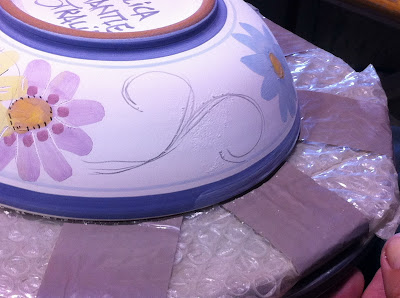When we bought this block of land in suburban East Fremantle we were optimistic parents of three gorgeous young lads and my clay education was on hold indefinitely. We had the hideous old sixties Fibro house removed and knew from the outset that the land slopes dramatically down from the street kerb to the back of the block and that we'd have to be smart about planning the landscaping. Getting the garden terraced with limestone walls was the easy part, then we built a third garage down the end of the grassy driveway for Henry's vintage Citroen cars along with a 7 foot 'pit' (though he is 5'8'). We refer to the pit as 'where we keep the bodies', and alongside his garage I got my small studio with paved verandah. Why am I telling you this? Well we were brilliant planners, except for one thing, a potter needs a kiln, a kiln is very heavy and must be handled by experts in heavy goods and moving a kiln down a steep grassy slope is not for the faint hearted. I spent Friday morning dealing in kiln movement, I needed to get my new one delivered, the old one removed, the divine german one I got in a garage sale moved from the family garage up top down to his lower garage. In fact I really want to evict Henry and have his lower garage and my studio all to myself but I suspect he'd object. He doesn't repond when I raise the subject, I wonder why.
We'd tried to have the new kiln delivered months ago but it proved hazardous and unstable trying to get it off the Hiab crane on truck onto our grass 'driveway 'for a start. That time John from Kilnswest drove off into the sunset with my kiln still on his truck, leaving me with suggestions of larger cranes and safe removal experts. Months passed, eventually Dean, the new Sales and Development Manager from Kilnswest phoned, determined to get my kiln to me and he did it .... except ... we only got it halfway down the side of the garden, well more than halfway, within metres of its destination actually and now it sits on a patch of lawn (on boards 'cos sunken kilns aren't in Vogue this season). It took Dean, Henry and our son Emmet a good couple of hours to get all this movement going including the truck getting bogged as WA soil is basically sand. The day was very hot I noted, as we crouched on roasting metal floor the back of the truck to weigh it down to help it get leverage and move up the driveway. I wore jeans as protection, I hadn't worn jeans for 6 months as the Summer here is long and hot. Jeans on a hot sticky day when you're climbing on and off the tray of a bogged truck = one hot cross bunny let me tell you. I love my house but I would NEVER recommend a potter live on a hill if they fancy getting a kiln delivered. Jeez I slept well that night.
Now Henry is hatching cunning plans to move the new kiln from lawn ornament mode into it's resting place - and I am 100% certain he will do it, eventually. I'll keep you posted.
We'd tried to have the new kiln delivered months ago but it proved hazardous and unstable trying to get it off the Hiab crane on truck onto our grass 'driveway 'for a start. That time John from Kilnswest drove off into the sunset with my kiln still on his truck, leaving me with suggestions of larger cranes and safe removal experts. Months passed, eventually Dean, the new Sales and Development Manager from Kilnswest phoned, determined to get my kiln to me and he did it .... except ... we only got it halfway down the side of the garden, well more than halfway, within metres of its destination actually and now it sits on a patch of lawn (on boards 'cos sunken kilns aren't in Vogue this season). It took Dean, Henry and our son Emmet a good couple of hours to get all this movement going including the truck getting bogged as WA soil is basically sand. The day was very hot I noted, as we crouched on roasting metal floor the back of the truck to weigh it down to help it get leverage and move up the driveway. I wore jeans as protection, I hadn't worn jeans for 6 months as the Summer here is long and hot. Jeans on a hot sticky day when you're climbing on and off the tray of a bogged truck = one hot cross bunny let me tell you. I love my house but I would NEVER recommend a potter live on a hill if they fancy getting a kiln delivered. Jeez I slept well that night.
Now Henry is hatching cunning plans to move the new kiln from lawn ornament mode into it's resting place - and I am 100% certain he will do it, eventually. I'll keep you posted.


































